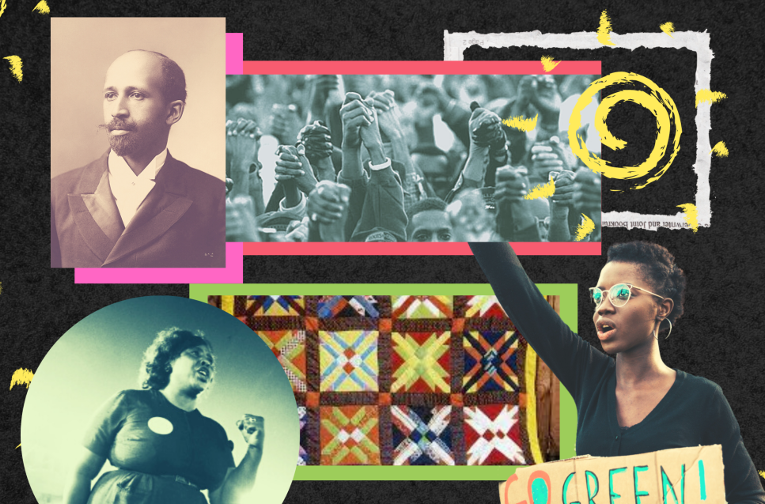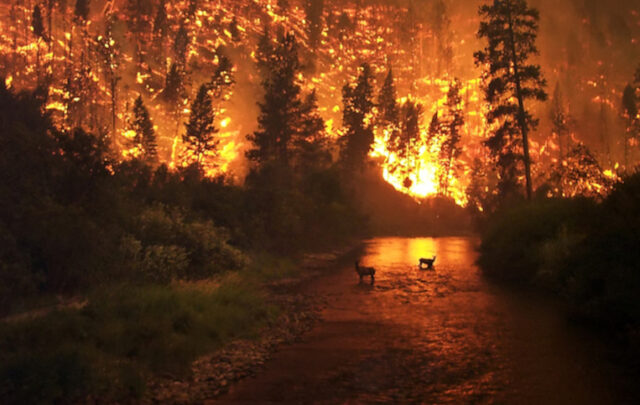For those of us interested in exploring alternative visions for the future of land, economy, and energy, the answers on how best to achieve collective liberation may come in lessons hard-learned from the past. Two places to start are Freedom Dreams: The Black Radical Imagination, which spans centuries from continental Africa to colonial America and the United States, and the “Black Freedom Struggle”, which offers transformative and regenerative possibilities for imagining and building a world without white supremacy.
The origins of modern radical Black thought
In wake of chattel slavery, amidst the U.S. government’s appalling departure from the promises of the 1866 Civil Rights Act and Reconstruction Amendments, Black radical thinkers such as Frederick Douglass, Maria Stewart, David Walker, Charles Lenox Remond, among others, demanded the country be rebuilt as an abolition democracy. In pursuit of self-determination and economic independence for Black citizens, Reconstruction-era racial advocates pushed community-building (schools, churches, social organizations), education, land ownership, and entrepreneurship. Compared to their liberal counterparts, who often sidestepped racial justice in favor of compromise and pragmatic reform, Black abolitionists offered holistic, aggressive, and forward-looking policies and initiatives to abolish chattel slavery, and transform the United States and the world.
As the 19th century reached its nadir, (in the words of W.E.B. DuBois) “…democracy died save in the heart of Black folk.” This is made clear in the words and writings of 20th and 21st-century Black thinkers who maintain the vision of a livable and community-oriented democracy.
Similar to the allies in this era, sharp sociopolitical and economic analysis of current events, and a basis of radical imagination, characterize each new generation of African American visionaries lamenting the failure of abolition democracy. Like our abolitionist ancestors, Black activists, intellectuals, and abolitionists today continue to imagine life outside of white supremacy (separation), capitalism (exploitation), and destructive development (energy), offering innovative and sustainable alternatives of community, cooperative economics, and land stewardship.
Rather than tinkering around the edges of oppressive institutions with reform, Black activists have consistently taken a radical stance in the face of racialized oppression and environmental destruction. From efforts to eradicate the slave trade, colonization, racial discrimination, and police brutality, to Black liberation and abolition movements, Black communities have understood the necessity of communal, economic, and sustainable power in pursuit of substantive transformation.
From white supremacy to community: Transforming our relationship with energy
Since the harnessing of electricity and the Industrial Revolution in the 18th century, the U.S.’s relationship with energy has been interwoven with the myth of the founding fathers, and rewritten without the consistent and fundamental contributions of African Americans. Black inventors such as Granville T. Woods — whose induction telegraph became Alexander Graham Bell’s telephone — Lewis Latimer’s long-lasting filament, which powered Thomas Edison’s lightbulb — and Dr. Philip Emeagwali’s formula that now powers the internet — were left out of the narrative.
But, in 2023 there is a renewed opportunity to center the innovations of African American inventors and innovators. For instance, the Cleveland Solar Cooperative is democratizing access to solar power. Inventors like Lonnie Johnson and Jessica O. Matthews with Uncharted.city are creating new decarbonizing technologies to power the future and save our planet.
Along with resourcing and crediting the innovations of Black thinkers, transforming the U.S.’s relationship with energy will also require us to unearth the labor and consumption patterns linked to a global history of imperialism and extraction.
As with communities across the African diaspora, Indigenous communities worldwide have faced genocide, displacement, and systemic exclusion due to ongoing colonization, pollution, and land theft. Furthering this violent legacy, the U.S. has continued to steal and encroach on land in Indigenous and Black communities, relying on eminent domain, political cover, and police violence.
Black radical thought has stood in support of Land Back and self-determination for all Indigenous peoples and communities, regardless of federal recognition, as well as reparations — in the form of land return and monetary repayment — for African Americans. Although the commission to study reparations may have stalled in the 116th Congress, our collective imagination has not.
From exploitation to cooperation: Transforming the capitalist economy
After the U.S. Civil War, the South set its sights on morphing economic exploitation and racial supremacy from slavery into convict labor and leasing, peonage, sharecropping, legal regulation, and violent vigilante prohibition of Black freedom, autonomy, and equality. Millions of former slaves across the Black Belt were trapped in predatory farming agreements and labor contracts, keeping generations of freed men and women beholden to southern plantations and farms through unending cycles of debt and trickery.
By mimicking the antebellum slave system’s reliance on captive Black labor, the post-Civil War United States — both North and South — morphed into a variety of white-supremacist economic and societal institutions; norms and customs that persist today. Sharecropping and convict leasing have been interchanged with factory, migrant, and prison labor, remodeling classic exploitative patterns for the modern plantation economy.
Atlanta, Georgia — often called “the Black Mecca,” with its Sweet Auburn business district and vibrant middle-class community — was often posited as the solution or alternative to this exploitative agrarian history. But growing up there, I bore personal witness to the “Atlanta Paradox”: the economic disparities between its thriving Black middle class and growing poor, and the tensions flamed between them by capitalist interests.
The necessary pillars of capitalism — profit-first, private ownership, worker exploitation, environmental exploitation, inequality, and political corruption — undermine the very premise of Black radical imagination. And the persistent inequities faced by both racialized and non-racialized communities under this inherently violent economic system make clear that it could never be the foundation of our collective liberation.
Despite the presence of multi-million dollar Black-owned businesses like the Atlanta Life Insurance Company and the Citizens Trust Bank, Black capitalism has not yet trickled down to a widespread economic improvement in Black communities. In fact, the appeal of acquiring individual affluence and economic success has historically been used to curtail Black radical thought and undermine ongoing struggles for collective socio-economic liberation. In the 1970s, resident Richard Nixon even heralded the approach as a capitalist alternative to “Black Power”.
What we have seen there is growing inequality. Nationally, the gap between the Black poor and Black middle class has grown since the post-war era. The racial wealth gap is persistent in income, unemployment, poverty, and asset ownership. The gap between Black and white incomes holds for all types of families, across income levels. These racial economic disparities are indicative not of failures in the predominant economic system, but an intended feature of it. And so, to navigate toward a more just economic reality for all, we’ll need to reject capitalist values in favor of the cooperativism, mutualism, and solidaristic practices that have historically kept us afloat.
From destructive development to stewardship: Restoring our planet
For much of recorded history, Black and Indigenous communities have acted as stewards of the land they occupy. This ecological reverence and knowledge have persisted even in colonized radicalized people, though the localized and globalized adoption of extractive environmental practices have often curtailed individual communities’ abilities to retain and implement regenerative practices.
Systems of oppression often overlap and form intersections that impact the most vulnerable communities. This is especially true in the arena of environmental justice. As Dr. Robert Bullard (the “Father of Environmental Justice”) famously stated: “America is segregated and so is pollution.” Following the industrialization of the nation, racialized communities in both rural and urban areas have disproportionately faced the degradation of their environmental realities. Large corporations often use Black and Brown neighborhoods as dumping grounds for their toxic waste byproducts, while limited green space and clean air are common. In the event of climate-related emergencies, these same communities are often left without the most basic environmental protections.
As the capitalist mindset of “profit over people and planet” continues to wreak ecological havoc on the world at large, in racialized communities especially, the fight to protect and defend ourselves and our environment has always been closely linked to our struggle to retain spatial, environmental and personal autonomy — a struggle that has been continually met with violence and/or inaction.
Nowhere is the intersection of capital, state violence, and environmental justice more evident that in the movement currently bubbling over in my hometown. Aptly named “Stop Cop City”, the grassroots effort is a citizen-led demonstration against the demolition of 381 acres of Weelaunee Forest, on Muscogee land in Atlanta, which the city hopes to claim in order to build a $90 million police-military training facility. Amid the ongoing struggle, the Georgia State Troopers, Atlanta Police Department, and other law enforcement officers have terrorized protestors with tactics reminiscent of Jim Crow policing, using canines, pepper spray, and partitions to harm and intimidate them. In December 2022, one of the brave forest defenders, Manuel Terán, was murdered by police in a SWAT raid on a protest encampment at Weelaunee People’s Park.
The brutal violence enacted specifically to uphold these compounding extractive systems illustrates the deep importance of our current work. We must transform our society by reforming our fractured individual and collective relationships to not only nature but shared resources, collective struggle, and to each other. The only way forward is to explore possibilities and stand in solidarity with the visionaries who call on us to do this work. This is an ongoing movement that can use your solidarity.





